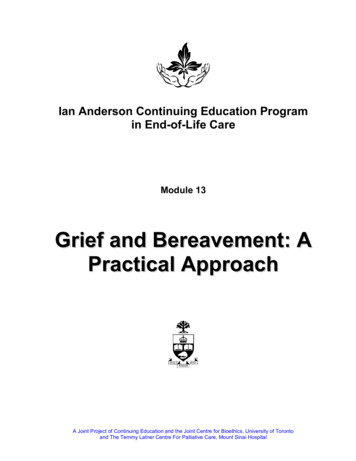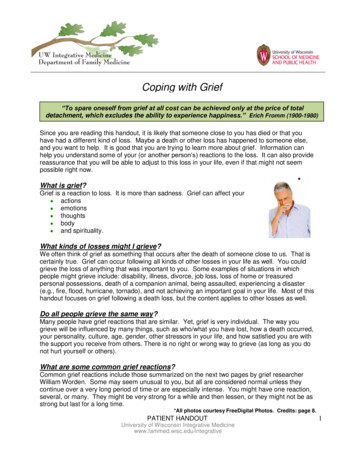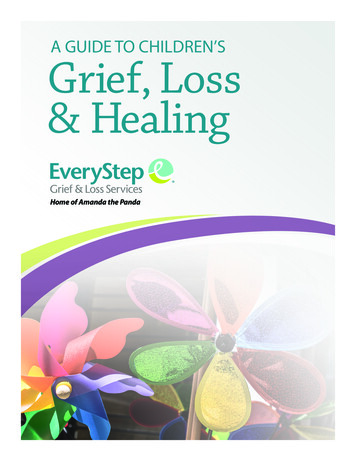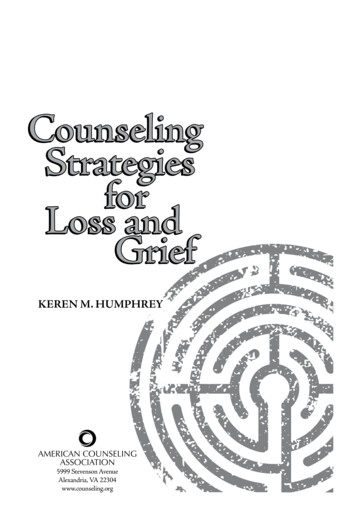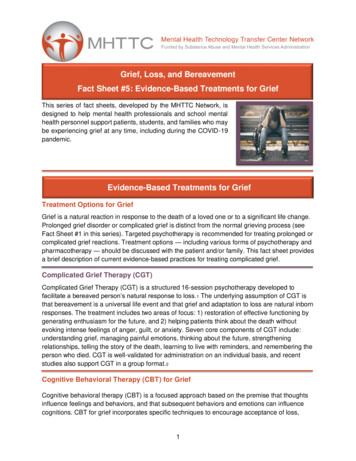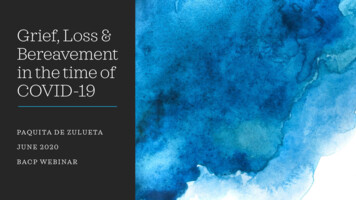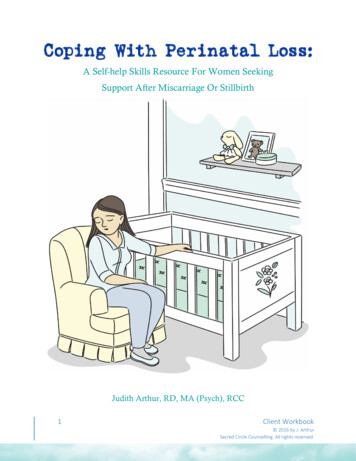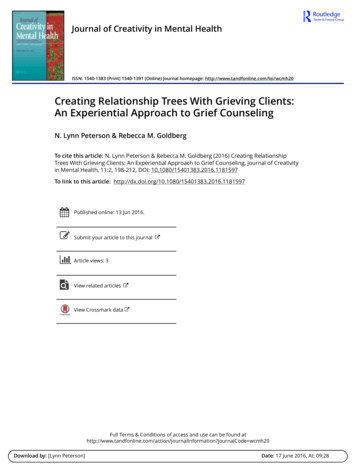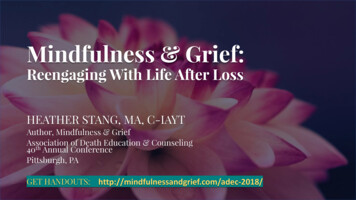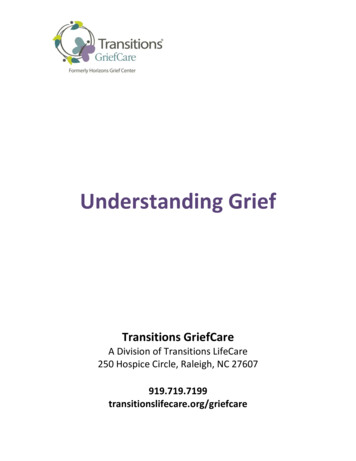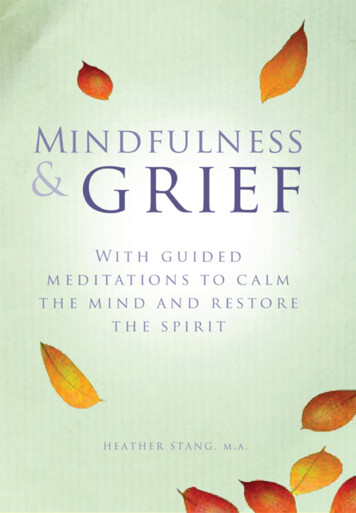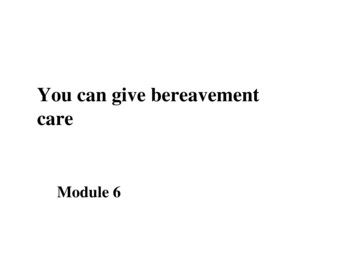
Transcription
You can give bereavementcareModule 6
Learning objectivesDescribe loss, grief, mourning,bereavement Explore theories of loss Outline the 9 cell tool Describe cultural practices around death Discuss bereavement care
DefinitionsBereavement is the loss of something ofvalue Grief is a person’s reaction to the loss Mourning is the behavior and actions ofsomeone who is bereaved
Bereavement / loss person death of parent, grandparent, sibling, partner,childdeath of close friendloss/breakup of relationshiploss of friendshipserious illness in self or otherpossession loss of role or financial securitychange in physical appearance
Grief person’s reaction to the loss– describes a range of emotions and reactionsdifferent types––––normal griefanticipatory grief happen before the loss occurscomplicated griefchronic grief
Group work Mary is a 32 year old woman with threechildren aged between five and 15. She hasa younger unmarried sister with whom sheis particularly close to. She has beendiagnosed with brain tumour a few weeksago. There are no options for curativetreatment. She has been discharged fromhospital.
Grief Group work––to explore reactions to loss in patients, familiesand health workerseach group should think about one characterfrom the scenario, imagining and discussinghow they might feel. (10 minutes)Group 1 is Mary Group 2 is her sister Group 3 is her home care nurse orvolunteer.
Grief reactions Case scenarioQueen Victoria"How I, who leant on him for alland everything—without whom Idid nothing, moved not a finger,arranged not a print or photograph,didn't put on a gown or bonnet if hedidn't approve it shall go on, to live,to move, to help myself in difficultmoments?"
Grief reactionsshock or disbelief anguish and severe distress anger searching for the lost one depression, fatigue, loss of interest in life acceptance and planning for the future
Theories of grief Stages– Four tasks of grieving– William WordenDual process model– Elizabeth Kubler-RossStroebe and SchutRebuilding life and search for meaning–Robert Neimeyer
Theories of grief Stages Denial Anger Bargaining Depression Acceptance Developed as stages of death and dying and notbereavement, not used as a framework for bereavementsupport
Theories of grief Tasks– Accept the reality of the loss– Work through the pain– Adjust to the new environment– Emotionally relocate the deceased person andmove on Tasks and their completion not as flexible as the next 2theories and less used now
Theories of grief Dual process– at times, individuals may be more focusedon coping with the loss itself, whereas atother times be more focused on adapting toan altered productive life– grieving may differ from one individual toanother, from one moment to another, andfrom one culture to another Very adaptable and widely used theory
Theories of grief Meaning reconstruction– loss in the context of our life stories; re-writingthe book or the story of your life– process of healing grief through the telling andre-telling of our life stories– seeking new meanings to re-affirm and re-buildour life in a world without our loved one– ‘Who are we now in the light of this loss’– http://livinglifedyingdeath.com/healing-grief/ Increasing interest as framework for narrative grief work
Mourning Mourning is the behavior and actions ofsomeone who is bereaved–––outward expression of griefincludes cultural factors and practicesincludes behaviors and rituals
Mourning p disturbancesappetite disturbancessocial withdrawaldreams of the deceasedabsent-minded behaviormemorializing or sharing memories
Mourning What are the customs, beliefs and practicesaround death in your culture?Which of these are helpful?Are any unhelpful and why?How could a palliative care team givebereavement support in this setting?
Grief assessment Begins at time of admission or diagnosisOngoing to recognise normal grief reactionto detect complicated grief
Bereavement experiences Useful framework to explore individual, cultural and societalissues and responses in bereavementCell numberCellletter123ImmediateAfter severalmonthsAfter a coupleof yearsAFeltA1A2A3BShownB1B2B3CAllowed/ ExpectedC1C2C39 cell tool for bereavement trainingJenny Hunt, Zimbabwe
Grief assessment Normal–emotional symptoms shock,anger, denial, anxiety, bargaining/yearning,depression, acceptance–physical Symptoms lackof energy, upset stomach, panic like attacks,tightness in the chest, shortness of breath–thoughts disbelief,confusion, sense of presence, lack ofconcentration
Grief assessment Normal all of these symptoms are normal, although notevery person will have every symptom.the bereavement period varies from person topersonmay be brief, or last many years generally is from months to one year Completion healing is when pain is lesswork of grief never really finishes
Grief assessmentWhat was the relationship Nature of the attachment Mode of death Personality variables Social variables* Adapted from William Worden. (1982). Grief Counseling and Grief Therapy. New York: Springer PublishingCompany.
Bereavement support How do we support grieving in practice?– http://www.goodlifedeathgrief.org.uk/
Bereavement support Establish a relationship with the bereavedBe comfortable with their expression of griefProvide presenceActive listening, touch, reassuranceNormalise grief reactionsCompanion them in rebuilding their life
Bereavement support You are the best therapeutic tool!!!!“Suffering is not a problem thatdemands a solution; it is not a questionthat demands an answer; it is a mysterythat demands a presence.” John Wyatt 1998
These resources are developed as part of the THETmulti-country project whose goal is to strengthen andintegrate palliative care into national health systemsthrough a public health primary care approach–––Acknowledgement given to Cairdeas InternationalPalliative Care Trust and MPCU for their preparation andadaptationpart of the teaching materials for the Palliative CareToolkit training with modules as per the Training Manualcan be used as basic PC presentations when facilitators areencouraged to adapt and make contextual
Grief assessment What was the relationship Nature of the attachment Mode of death Personality variables Social variables * Adapted from William Worden. (1982). Grief Counseling and Grief
